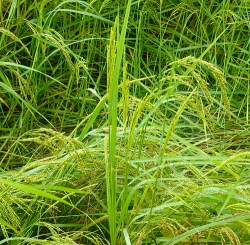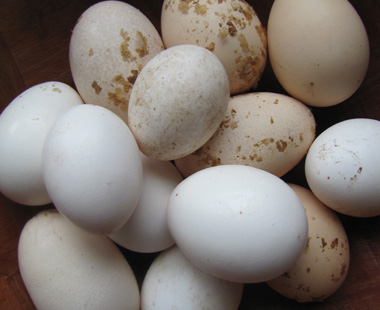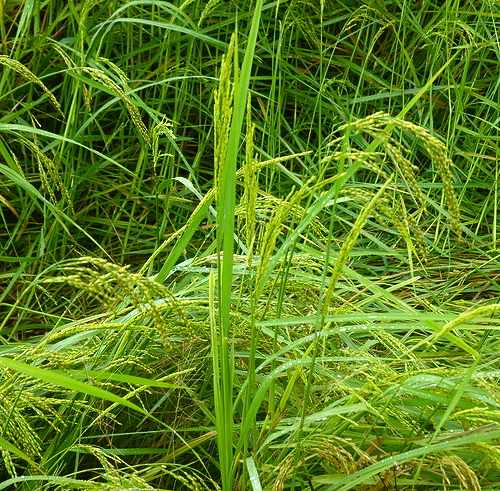
This rice might look like the type farmers cultivate for food, but it’s a weed. And as CO2 levels in the air rise, it might just take over. (Photo courtesy of The International Rice Research Institute.)
Climate change may be wreaking havoc on ecosystems and food supplies around the world, but there are also some things it’s really great for — like weeds.
According to research published last month in the journal PLoS ONE, weeds love carbon dioxide. Or, more precisely, they’re learning to love CO2 because they can adapt quickly to most conditions. Crops grown for food, on the other hand, don’t adapt because they’re designed not to — you want things like rice or wheat to have the same reliable taste, right? That’s why farmers take great care when they’re choosing the kinds of seeds they want to grow.
Now, thanks to climate change, that consistency is also a huge risk. The study in PLoS ONE, conducted by some forward-thinking researchers at the U.S. Department of Agriculture (USDA), found that as CO2 levels rise, weeds fare better than their domesticated crop counterparts. That’s because the weeds adapted. But that’s not all: It turns out exposure to CO2 also makes them behave a little like zombies. In other words their weed-like qualities were also contagious (via gene transfer), and the actual crops began behaving more like weeds.
There’s already concern about genetic contamination from GMO food crops to weeds. Now there’s evidence that weeds could compromise food crops. (And we’re not even talking about “superweeds,” which are pretty scary in their own right because of their rapid growth and resistance to herbicides.)
The science
The USDA researchers grew two types of rice side by side — a wild, weedy variety (known colloquially as “red rice” for the color of the grains) and a cultivated variety called Clearfield 161, which is chemically altered (but not genetically modified) to be herbicide-resistant. As they raised carbon dioxide levels at the test site, the researchers found that the weedy rice did better, but not because it grew faster — what it did was transfer genes into the cultivated crop, making the Clearfield rice “essentially a weed,” said Lewis Ziska, a USDA plant physiologist who co-led the study. The weedy, wild rice isn’t what most people consider “wild rice.” Ziska says people could eat it if they had to, but most of us wouldn’t want to. And rice from the plants that were genetic cross between the weedy and crop rice tended to be more fragile (with the hulls cracking easily) with a lower nutrient content.
“That’s sort of the science fiction aspect of this,” Ziska told Science News. The article says he “likens the scenario to Invasion of the Body Snatchers” when he says, “Whatever [seed] the good plant produces is now going to be bad seed.”
The research also has some eye-opening implications for our entire food supply: Ziska said he expects that what happened to rice will happen to other crops, if and when CO2 levels rise. Many cultivated crops have weed counterparts that are almost identical genetically. They also often look very much alike — making them hard for a farmer to fight.
In other words, the crops we rely on for sustenance could be dominated by bigger and more aggressive weeds as climate change worsens. And that’s leaving aside any issues with genetic modification and changes in water levels or temperature, all of which have been linked with falling crop yields or the rise of superweeds.
What is it about weeds that makes them seem so indomitable?
“You are selecting for weeds in particular because what weeds do is they come up quickly. They generate a lot of seed; they have very quick growth cycles,” said the scientist. “They’re constantly growing and producing new DNA. And over time, that DNA is going to be selected for. What we think has happened is that that DNA is being selected for by the change in CO2.”
When in the zombie apocolypse …
The news isn’t necessarily all bad. The upside, says Ziska, is that if these wild rice relatives are behaving like weeds because of natural selection, then the possibility exists to use traditional breeding methods to find ways to give productive crops weed-like qualities that make them more resilient.
“The weeds are doing what weeds have always done, and that is adapt very quickly to a very sudden change in circumstance — and maybe that’s our role model. Maybe that’s the thing that we should look at as a strategy for being able to very quickly adapt in agriculture to what’s happening to the globe as a whole,” says Ziska.
That’s the focus of some follow-up research the scientist has been involved in. He believes that allowing cultivated crops to adapt to changing conditions — as the weeds are doing — could be an easy, cheap way to manage the increasing pressures on the global food supply. Not that emulating weeds would be a magic-bullet solution; but it could be a part of a larger approach to dealing with both climate change and an explosive demand for food as the world population climbs ever higher.
And because it relies on principles borrowed from nature — rather than trying to defy nature, as much of biotechnology does — the potential for success seems that much greater.
“Can we do what nature’s been doing for the last 50 years, and can we do it in an accelerated way so that we can begin to take advantage of this additional resource in terms of making more seed yield?” Ziska asks, optimistically. “This is particularly imperative at a time when there is so much pressure being put on the global food supply.”




